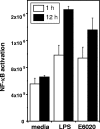Synthetic Toll-like receptor 4 agonist enhances vaccine efficacy in an experimental model of toxic shock syndrome
- PMID: 17715328
- PMCID: PMC2168172
- DOI: 10.1128/CVI.00153-07
Synthetic Toll-like receptor 4 agonist enhances vaccine efficacy in an experimental model of toxic shock syndrome
Abstract
The development of new protein subunit vaccines has stimulated the search for improved adjuvants to replace traditional aluminum-containing products. We investigated the adjuvant effects of a synthetic Toll-like receptor 4 (TLR4) agonist on vaccine efficacy in an experimental model of toxic shock syndrome. The TLR4 agonist E6020 has a simplified structure consisting of a hexa-acylated acyclic backbone. The vaccine examined is a recombinantly attenuated form of staphylococcal enterotoxin B (STEBVax). Using cells stably transfected with TLRs, E6020 transduced signals only through TLR4, suggesting monospecificity, while Escherichia coli 055:B5 lipopolysaccharide activated both the TLR2/6 heterodimer and TLR4. Coadministration of E6020 with STEBVax, by the intramuscular or intranasal route, induced significant levels of immunoglobulin G (IgG) in BALB/c mice. Further, increased IgG production resulted from the combination of E6020 with aluminum hydroxide adjuvant (AH). The antibody response to the vaccine coadministered with E6020 was a mixed Th1/Th2 response, as opposed to the Th2-biased response obtained with AH. Mice vaccinated with STEBVax coadministered with AH, TLR4 agonists, or a combination of both adjuvants were protected from toxic shock. Our data demonstrate the effectiveness of the synthetic TLR4 agonist E6020 as an alternative adjuvant for protein subunit vaccines that may also be used in combination with traditional aluminum-containing adjuvants.
Figures






References
-
- Boles, J. W., M. L. Pitt, R. D. LeClaire, P. H. Gibbs, E. Torres, B. Dyas, R. G. Ulrich, and S. Bavari. 2003. Generation of protective immunity by inactivated recombinant staphylococcal enterotoxin B vaccine in nonhuman primates and identification of correlates of immunity. Clin. Immunol. 108:51-59. - PubMed
-
- Chow, J. C., D. W. Young, D. T. Golenbock, W. J. Christ, and F. Gusovsky. 1999. Toll-like receptor-4 mediates lipopolysaccharide-induced signal transduction. J. Biol. Chem. 274:10689-10692. - PubMed
-
- Corbel, M. J. 1996. Reasons for instability of bacterial vaccines. Dev. Biol. Stand. 87:113-124. - PubMed
-
- Fekety, F. R., Jr. 1969. Skin window studies of the effect of endotoxin upon the acute inflammatory response. Johns Hopkins Med. J. 124:291-295. - PubMed
-
- Fraser, J., V. Arcus, P. Kong, E. Baker, and T. Proft. 2000. Superantigens—powerful modifiers of the immune system. Mol. Med. Today 6:125-132. - PubMed
MeSH terms
Substances
LinkOut - more resources
Full Text Sources
Other Literature Sources

